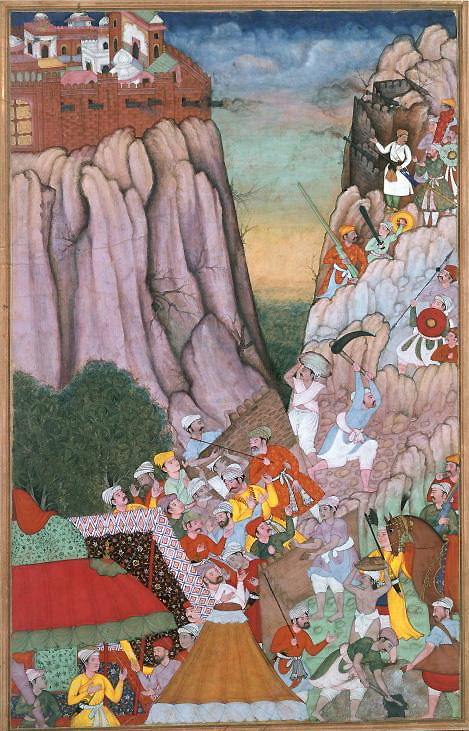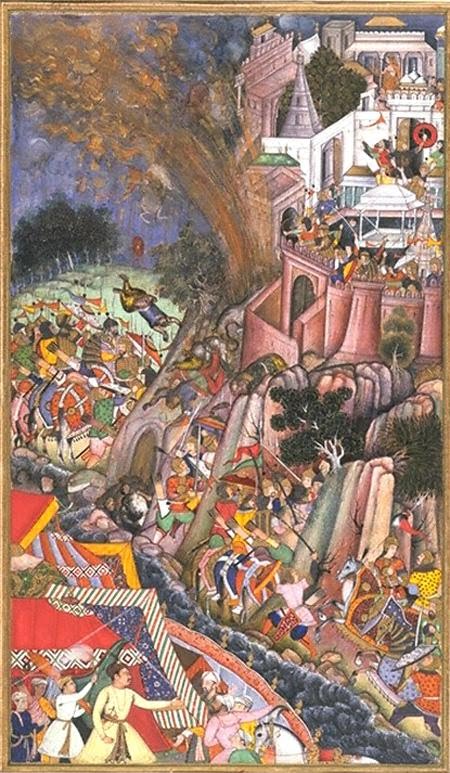
|
|
|
|
BY: SUN STAFF

Akbar's Assault on Ranthambhor Jun 01, 2010 — CANADA (SUN) — A serial presentation of the Mughal effect on Vaisnava society. Among the most devastating of Akbar's violent campaigns against the Hindus was the massacre at Chittor, Rajasthan. There, the Mughal emperor's forces took the Chittor (Chittaurgarh) Fort, killing 8,000 Rajputs and an estimated 30,000 citizens. Some of the people who died there lived inside the fort, but most were local villagers who had taken refuge in the fort.
The assault at Chittor went on from October 23, 1567 to February 24, 1568 A.D. Heralded as one of Akbar's great accomplishments, the routing of Chittor was depicted in detail in the Akbar-nama, which included the miniature paintings seen on this page. The campaign began with the assault of several smaller forts in Mewar, which the Mughal army easily took before surrounding Chittor. Taking the well fortified structure at Chittor was not such an easy matter, however. Akbar's men began by digging beneath the fort walls and planting explosives, but their plans were foiled when the charges went off prematurely, killing many of their own men and horses. Meanwhile, the Rajputs shot arrows and rained stones down upon the heads of Akbar's men.

Akbar's Assault on Chittor Failing to breach the walls of Chittor Fort, the Mughals constructed towers from which they had a better vantage point to attack the fierce kshatriya Rajputs. In the above illustration from Akbar-nama, the colorful awnings of Akbar's tower are seen in the bottom left. Akbar, in yellow tunic, has shot the Rajput general, Jaimal Rathore, who is seen inside the fort, in the upper right corner (left of the red disc). Although the perimeter of the fort has been breached in several places, with Mughals storming the walls, Chittor stands defended in this scene. On the day before the siege of Chittor came to an end, Rajput women and children inside the fort performed jauhar, voluntarily taking their lives in order to avoid capture and dishonor at the hands of the enemy. The men prayed for courage in their final battle, as they prepared to die, taking as many of Akbar's soldiers with them as possible.

Assault on Chittor Fort Before Akbar's assault on the forts in Mewar, some of the Hindu defenders left the forts, taking up positions in the surrounding hills. Maharana Udai Singh, who was the king of Mewar, founder of Udaipur, and the father of Maharana Pratap, joined these rebel leaders. Moving his family out of the fort, which he saw to be a death trap, he moved them to a camp in the western Aravalli Hills. From there, he used his own men and horses to attack and harras the Mughal army at every opportunity, while they lay siege to Chittor. Ultimately, Akbar's forces were stronger and greater in number than the Rajput and Mewari defenders. The Mughals ransacked the villages around Mewar to prevent them from supplying the fort's defenders. As we see in the painting above, the Mughals constructed walls around Chittor Fort, laying their own guns in place for the main assault. In addition to the thousands of women and children who committed jauhar, an estimated 30,000 Hindu men are believed to have been massacred by the Muslims at Chittor, which stood as a major victory in Akbar's campaign. With the Hindu masses destroyed, Akbar's armies turned their attention to Ranthambhor, where we'll continue with the next three-part segment of this series. The Chittor Fort was very strategically positioned, laying along the shortest route between Agra and Gujarat, also a key thoroughfare to central Rajasthan. While some historians suggest that the severity of the Chittor massacre is understandable, given Akbar's need to capture this strategic fort, Chittor was not the only such campaign of violence Akbar perpetrated upon the Hindus. In another segment, we'll discuss the massacre of sadhus at Thanesar (Haryana), where Akbar set his men upon a large congregation of sannyasis taking bath at the temple tank.

Entry into Ranthambhor
| |